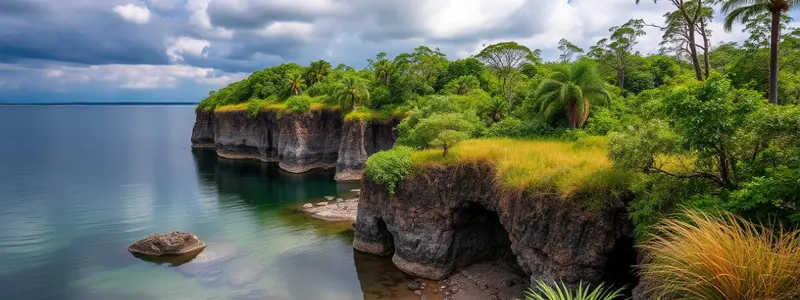Podcast
Questions and Answers
Which of the following is NOT considered an ecosystem service?
Which of the following is NOT considered an ecosystem service?
- Ecosystem Fragmentation (correct)
- Water Purification
- Pollination
- Nutrient Cycling
What is genetic diversity?
What is genetic diversity?
- The total biomass of plants and animals in a habitat
- The variety of ecosystems in a region
- The amount of variation in genetic material within a population (correct)
- The number of different species in an area
How does biodiversity loss contribute to climate change?
How does biodiversity loss contribute to climate change?
- It enhances the carbon dioxide absorption capacity of plants.
- It decreases the amount of carbon dioxide removed from the atmosphere. (correct)
- It increases the number of invasive species.
- It promotes stronger ecosystem services.
Which of the following phenomena is a direct threat to ecosystems?
Which of the following phenomena is a direct threat to ecosystems?
What does ecosystem diversity refer to?
What does ecosystem diversity refer to?
Which event is characterized by the warming of the ocean and can lead to severe weather phenomena?
Which event is characterized by the warming of the ocean and can lead to severe weather phenomena?
What is the primary consequence of red tide blooms caused by dinoflagellates?
What is the primary consequence of red tide blooms caused by dinoflagellates?
Which of the following is a primary cause of oxygen depletion in aquatic environments?
Which of the following is a primary cause of oxygen depletion in aquatic environments?
What is one major effect of deforestation on the ecosystem?
What is one major effect of deforestation on the ecosystem?
Which of the following is NOT a reason for deforestation?
Which of the following is NOT a reason for deforestation?
How do invasive species most commonly enter new ecosystems?
How do invasive species most commonly enter new ecosystems?
What process is defined as the addition of harmful substances to the environment?
What process is defined as the addition of harmful substances to the environment?
What is a common result of habitat alteration?
What is a common result of habitat alteration?
Which of the following is NOT considered a man-made hazard to ecosystems?
Which of the following is NOT considered a man-made hazard to ecosystems?
What can be a consequence of overexploitation of renewable resources?
What can be a consequence of overexploitation of renewable resources?
Which substance is NOT considered a main air pollutant?
Which substance is NOT considered a main air pollutant?
Which of the following are considered major water pollutants?
Which of the following are considered major water pollutants?
What is a primary characteristic of coral reefs?
What is a primary characteristic of coral reefs?
Which of the following is a major threat to coral reefs?
Which of the following is a major threat to coral reefs?
What is one of the main approaches to maintain and protect wildlife?
What is one of the main approaches to maintain and protect wildlife?
The Endangered Species Act was signed into law to:
The Endangered Species Act was signed into law to:
What are the effects of inbreeding depression observed in the Florida Panther?
What are the effects of inbreeding depression observed in the Florida Panther?
The Multiple-use Act of 1920 primarily directs the management of national forests for which purposes?
The Multiple-use Act of 1920 primarily directs the management of national forests for which purposes?
What is one of the impacts of human runoff on coral reefs?
What is one of the impacts of human runoff on coral reefs?
What category does the Red Panda fall under in terms of conservation status?
What category does the Red Panda fall under in terms of conservation status?
Which of the following is NOT a reason for biodiversity loss caused by human impact?
Which of the following is NOT a reason for biodiversity loss caused by human impact?
What does the 'Near-Threatened' classification indicate about a species?
What does the 'Near-Threatened' classification indicate about a species?
What percentage of species could potentially be extinct in 5 centuries at the current rate of extinction?
What percentage of species could potentially be extinct in 5 centuries at the current rate of extinction?
Which of the following species is classified as 'Least Concern'?
Which of the following species is classified as 'Least Concern'?
What is the main purpose of the Convention on International Trade in Endangered Species of Wild Fauna and Flora (CITES)?
What is the main purpose of the Convention on International Trade in Endangered Species of Wild Fauna and Flora (CITES)?
Which Act established federal responsibility to conserve marine animals?
Which Act established federal responsibility to conserve marine animals?
What does the status 'Critically Endangered' indicate about a species?
What does the status 'Critically Endangered' indicate about a species?
Which of the following is true about the conservation status created by the IUCN?
Which of the following is true about the conservation status created by the IUCN?
What does 'Extinct' mean in terms of species conservation?
What does 'Extinct' mean in terms of species conservation?
What does 'Extinct in the Wild' imply about a species?
What does 'Extinct in the Wild' imply about a species?
What typically triggers a species to be classified as Endangered?
What typically triggers a species to be classified as Endangered?
What is most commonly responsible for species moving to the Critically Endangered category?
What is most commonly responsible for species moving to the Critically Endangered category?
Flashcards are hidden until you start studying
Study Notes
Ecosystem Services
- Ecosystem services are benefits provided by wildlife and ecosystems to humans, including decomposition, water purification, nutrient cycling, and pollination.
- Decomposition involves breaking down organic material, while water purification filters pollutants through ecosystems like wetlands and forests.
- Pollination is essential for plant fertilization and maintaining food supplies.
Biodiversity Loss
- Biodiversity loss poses an existential risk similar to climate change, driven by ecosystem fragmentation, invasive species, pollution, and overexploitation.
- Deforestation, particularly in the Amazon, significantly decreases the carbon dioxide absorption capacity of plants.
What is Biodiversity?
- Biodiversity encompasses all plant and animal life in a region, divided into three levels: species diversity, genetic diversity, and ecosystem diversity.
Threats to Ecosystems
Natural Hazards
- Red Tide: Algal blooms causing toxins that contaminate marine life and affect human health.
- El Niño and La Niña: Climate variations leading to severe droughts and floods.
Man-Made Hazards
- Bombings and nuclear fallout release radiation, causing long-term health issues.
- Deforestation for urban development, agriculture, and resource extraction leads to soil erosion, flooding, and biodiversity loss.
Causes of Biodiversity Loss
- Habitat alteration involves changes in land use that impact local ecosystems (e.g. farming, urbanization).
- Invasive species disrupt native ecosystems and outcompete local species.
- Pollution, including water and air contamination, adversely affects species health and biodiversity.
- Overharvesting threatens renewable resources, leading to diminished populations.
Invasive Species
- Non-native species, such as cane toad and zebra mussel, can outcompete and harm native species when introduced to new environments.
Pollution
- Water Pollution: Contamination from sewage, pesticides, and industrial waste.
- Air Pollution: Harmful atmospheric contamination affecting health and safety, including pollutants like carbon monoxide and sulfur dioxide.
Coral Reef Destruction
- Coral reefs, dubbed “rainforests of the ocean”, are vital habitats but face threats from dynamite fishing, tourism, and human runoff.
Endangered Species
- Siberian Tiger: Hunted extensively, now inhabiting areas in Russia's Sikhote Alin range.
- Florida Panther: Critically low population due to hunting and habitat loss; fewer than 100 remain in the wild.
Conservation Approaches
- Species Approach: Legislative protection of endangered species.
- Ecosystem Approach: Preservation of balanced ecosystems.
- Wildlife Management Approach: Sustainable management of game species through international treaties.
Endangered Species Act
- Signed in 1973, it prohibits actions that harm endangered species or their habitats and aims to prevent extinction and stabilize populations.
Important Laws and Treaties
- Multiple-use Act (1920): Aims to manage national forests for diverse uses.
- CITES (1963): Prevents trade of endangered species impacting their survival.
- Marine Mammal Protection Act (1972): Ensures conservation of marine animals.
Conservation Status
- IUCN's Red List categorizes species as extinct, extirpated, critically endangered, endangered, vulnerable, near-threatened, or of least concern.
Extinction Categories
- Extinct: No individuals remain, cannot be recreated; e.g., Quagga.
- Extinct in the Wild: Species surviving only in captivity; e.g., Hawaiian Crow.
- Critically Endangered: High risk of extinction; e.g., Black Rhino.
- Endangered: Recently decreased populations; e.g., Red Panda.
- Vulnerable: Signs of decline but not yet endangered; e.g., Polar Bear.
- Near-Threatened: Potential to become endangered; e.g., Beluga Whale.
- Least Concern: Stable populations with a wide range; e.g., Humans.
Human Impact
- Major drivers of biodiversity loss include habitat fragmentation, climate change, pollution, and overconsumption.
- Current extinction rates could lead to a sixth mass extinction, with projections suggesting 75% of species could be extinct in 500 years.
Studying That Suits You
Use AI to generate personalized quizzes and flashcards to suit your learning preferences.




